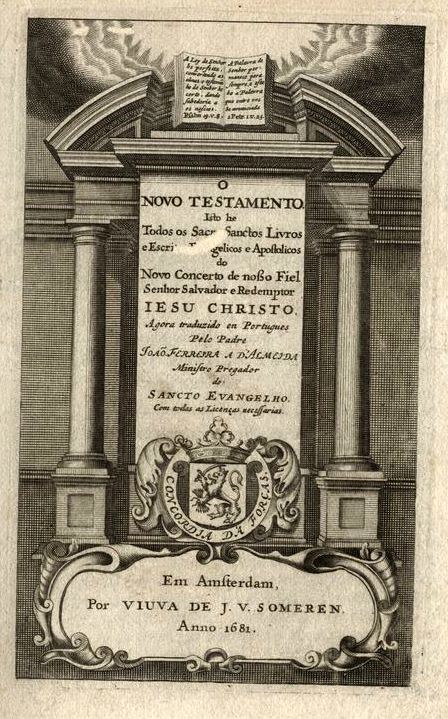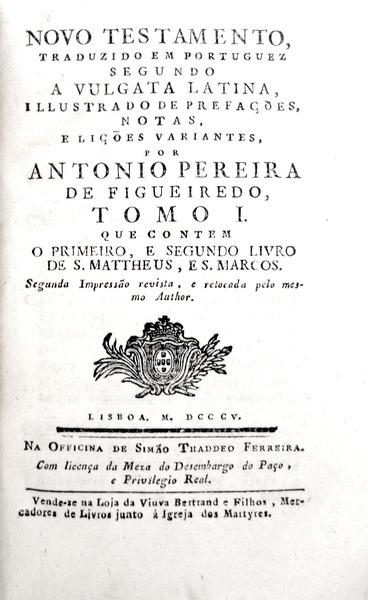The First Portugese Bibles
The First Portuguese Bibles
By Amanda Robin Hemmons
Introduction
At heart, the Bible has always been a multi-lingual affair. What we call the Old Testament is based on ancient versions of the Hebrew Tanakh, and the New Testament was written in Greek. Latin translations of the Bible were strongly favored over the next few centuries, although the Latin Vulgate version of the Bible was not officially authorized by the Catholic church until 15901.
Being a Catholic country, Portugal aligned with the Pope’s preference for Latin Bibles. It wasn’t until the Protestant Reformation of the 16th century that a complete version of the Bible in vernacular Portuguese appeared.
| Title | O Novo Testamento | A Sancta Biblia; contendo o Velho e o Novo Testamento |
|---|---|---|
| Date | 1681 | 1821 |
| Place | Amsterdam, The Netherlands | London, England |
| Contributor(s) | Translated by Pastor João Ferreira de Almeida | Translated by Father António Pereira de Figueiredo |
| Language(s) | Portuguese | Portugese |
| Source | Available on Archive.org [Link] | Available on Archive.org [Link] |
Protestant vs Catholic
The oldest complete translation of the New Testament into Portuguese was done by João Ferreira de Almeida. He began as a young man living in Malacca (modern day Malaysia), before moving to Batavia (currently Jakarta), where he started his theological studies with ministers of the Dutch Reformed Church2. Almeida worked on the translation for over a decade and saw the New Testament finally published in 1681 in Amsterdam3. It’s likely that the European maritime expansion, with particular emphasis on the Portuguese and Dutch expansions (and the interactions between these colonial powers), had something to do with the popularity of this translation.
Throughout his life, Almeida was very vocal about his opposition to the Catholic Church and wrote multiple treatises outlining the church’s flaws and engaging in theological debate with Catholic priests. By the year he died, he had translated almost the entire Old Testament, but left the work unfinished with final verses of Ezekiel’s prophecies. Revisions would follow over the decades, as well as work to complete the Old Testament, but it wasn’t until a century later that the first Catholic translation attempt would be made.
In contrast to Almeida, Father António Pereira de Figueiredo lived and worked in Portugal his whole life. He studied Latin, Rhetoric and Theology at the Monastery of Santa Cruz de Coimbra and was a professor as well as clergyman at the Casa do Espírito Santo of the Congregation of the Oratory. Like Almeida, his translation took many years to complete. He published at first in parts, with the New Testament released between 1778 and 1781, and the Old Testament between 1782 and 1790, for a total of 23 volumes. A shortened complete version in 7 volumes was published in 1819, but it wasn’t until 1821 that a single volume version appeared, published in London.
Shockingly, the first complete collection of Almeida’s Bible, combining both Old and New Testaments together in one volume, did not appear until this time, also printed and published in London in 1819.


The Gospels
The major differences between the Protestant and the Catholic Bibles are generally accepted to be in the books of the Old Testament. Therefore there isn’t– officially– a difference between the New Testaments of the two religious sects. In fact, when the London Bible Society was selecting which edition of the Bible to be printed and distributed in 18194 in Portugal, they ended up choosing Almeida’s, despite the fact that the great majority of Portugal was Catholic. At the time, the assumption was that Almeida’s translation was based off of the older Greek and Hebrew versions, while Figueiredo’s was based off the newer Latin Vulgate. For Biblical studies, these older texts are generally preferred as being closer to the “original” and made Almeida’s Bible more appealing.
However, Almeida’s actual fluency in Greek and especially Hebrew has since been called into question. That, and the comparatively archaic language used, led to Figueiredo’s Bible overtaking Almeida’s by the mid-1800s5. By the 20th century, Figueiredo’s Bible was the preferred text of both Portugal and Brazil, to the point that even Protestants would use it for evangelisation purposes as well as in their own services.
Editora Eldebra still publishes a version of this Bible6 in Brazil today, corrected for modern Portuguese. Pre-1928 editions are much sought after because they contain the apocryphal books that were included in the Catholic Bible at the Council of Trent.
https://storymap.knightlab.com/ 7
- Metzger, “VII The Latin Versions,” pg 8. ↩︎
- Cavaco, “Almeida bible,” pg 4. ↩︎
- Menezes Fernandes, “A literatura religiosa,” pg 15. ↩︎
- Cavaco, “Almeida Bible,” pg 8. ↩︎
- Cavaco, “Almeida Bible,” pg 8. ↩︎
- “Outras Traduções Pós Almeida.” ↩︎
- “Traduções em Ordem Cronológica.” ↩︎
Bibliography
Cavaco, Timóteo. (2023). “Almeida Bible—Keeping a Heritage Alive: The Historical Path and Current Challenges of a Seventeenth-Century Translation.” The Bible Translator. United Bible Societies, 2023. https://journals.sagepub.com/doi/pdf/10.1177/20516770231154264
Menezes Fernandes, Luis Henrique. “A literatura religiosa polemista nas Índias Orientais seiscentistas e a elaboração da primeira tradução regular da Bíblia em língua portuguesa (1642-1694).” Universidade de São Paulo, 2013.
Metzger, Bruce M. VII The Latin Versions: The Early Versions of the New Testament. Oxford: Clarendon Press, 1977.
“Outras Traduções Pós Almeida.” Bíbliateca Teológica, 03 May 2023. https://bibliateca.com.br/site/a-biblia-em-portugues/outras-traducoes-pos-almeida
“Traduções em Ordem Cronológica.” Bíbliateca Teológica, 03 May 2023. https://bibliateca.com.br/SITE/a-biblia-em-portugues/traducoes-em-ordem-cronologica



